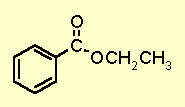PROBLEM #13
The following data is available from the question:
MS: M+ = 150 g/mol. No Cl or Br isotope pattern.
IR: There is a C=O absorption at 1720cm-1. Other
strong absorptions at 1275 and 1110cm-1 suggest C-O bonds. Since
there is no -OH, it is not an alcohol or carboxylic acid.
13C nmr: The proton decoupled spectrum shows 7 peaks indicating
7 types of C. By analysis of the chemical shifts, we have a very
deshielded C at 167ppm (C=O, most likely a carboxylic acid derivative as
aldehydes and ketones are usually > 190ppm), 4 aromatic C at 133, 131,
130 and 128ppm, a deshielded peak at 61ppm possibly for a C-O, and a peak
at 14ppm that is probably from a simple hydrocarbon portion.
1H nmr: First of all we have 4 types of H showing up.
After this, it's a good idea to tabulate the information to make sure you
get it all correctly matched up:
|
d/ppm
|
multiplicity
|
integration
|
Inference
|
|
8.0
|
multiplet
|
2
|
5 ArH : monosubstituted aromatic |
|
7.5
|
multiplet
|
3
|
|
4.4
|
quartet
|
2
|
deshielded -CH2- coupled to 3H
|
|
1.4
|
triplet
|
3
|
CH3 coupled to 2H |
The coupling patterns for the -CH3 (1.4 ppm, a triplet) and
the -CH2- (4.4 ppm, a quartet) indicate that they are connected
to each other to form an ethyl group :
CH3CH2- . The deshielded chemical
shift around 4ppm for the -CH2- is consistent with it being
attached to an O atom.
Summary....
The MS indicated MW = 150 g/mol
The IR showed the presence of a C=O and C-O.
13C peak at 167ppm and 61ppm match the C=O and C-O indicated by the
IR.
H nmr peaks suggests a CH3-CH2-O- unit, plus
a monosubstituted aromatic C6H5-
So with this information we have the following pieces: CH3-CH2-O-,
C=O and C6H5-
Use this to check a partial molecular formula : C9H10O2
= 9 x 12 + 10 x 1 + 2 x 16 = 150g/mol
This confirms that we have all the pieces.
Altogether...
With the pieces we have : CH3CH2O-
, C=O and the C6H5-
This means we only have 2 end groups which can only be out together
in one way.
Note that the chemical shift for the -CH2- in the ethyl
group (4.1ppm) is important as it indicates that it is attached to the
-O- and not the C=O.
The IR for the C=O at 1720cm-1 is lower than a typical ester
since it is conjugated. |

ethyl benzoate
|
The final step should always be to check what you have drawn.
The easiest thing to check is usually the coupling patterns you would
expect to see, and the chemical shifts of each unit.
You should be asking yourself : "Does my answer give me what the
H-nmr shows ?"
